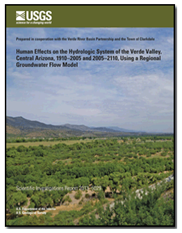Learn
Why is this study important?
This study applies USGS Northern Arizona Regional Groundwater-Flow Model to directly examine the effect of groundwater pumping across the model area on the timing and magnitude of changes of base flow at the Paulden, Clarkdale, and Camp Verde streamgages. Similarly, it examines other hydrologic-system effects through time such as net underflow, storage change, and depth to groundwater within the Verde Valley (defined for this report as the drainage basin between the Clarkdale and Camp Verde streamgages.
U.S. Geological Survey Scientific Investigations Report 2013-5029.
by Garner, B.D., Pool, D.R., Tillman, F.D., and Forbes, B.D., 2013. Water budgets were developed for the Verde Valley of central Arizona in order to evaluate the degree to which human stresses have affected and might yet affect the hydrologic system. The Verde Valley is a portion of central Arizona wherein concerns have been raised as to water availability, particularly perennial base flow on the Verde River. The Northern Arizona Regional Groundwater Flow Model (NARGFM) was used to generate the water budgets. The NARGFM was run in several configurations for the 1910-2005 and 2005-2110 time periods, and the resultant water budgets were subtracted from one another in order to quantify the relative changes that were attributable solely to human stresses (where human stresses included groundwater withdrawals and incidental and artificial recharge). This approach to subtracting water budgets required an assumption of linear model response. Three hypothetical and varied conditions of human stresses were developed for the 2005-2110 period. On the basis of this analysis, human stresses during 1910-2005 were found to have affected the hydrologic system of the Verde Valley, and human stresses will continue to affect the hydrologic system human stresses, as well as base flow and net groundwater discharge in the Verde Valley. Base flow at the upstream end of the study area, as of 2005, was simulated as being about 4,900 acre-feet per year less than it would have been had there been no human stresses. At the downstream end of the Verde Valley, base flow was about 10,000 acre-feet per year less for these same reasons. For the 2005-2110 period, base flow at downstream end of the Verde Valley was simulated as decreasing by an additional 5,400 to 8,600 acre-feet per year because of past, ongoing, and hypothetical future human stresses. The process known as capture (or streamflow depletion) was the reason for these human-stress induced changes in water-budget components. The FULL REPORT and an accompanying USGS Fact Sheet are available online.





